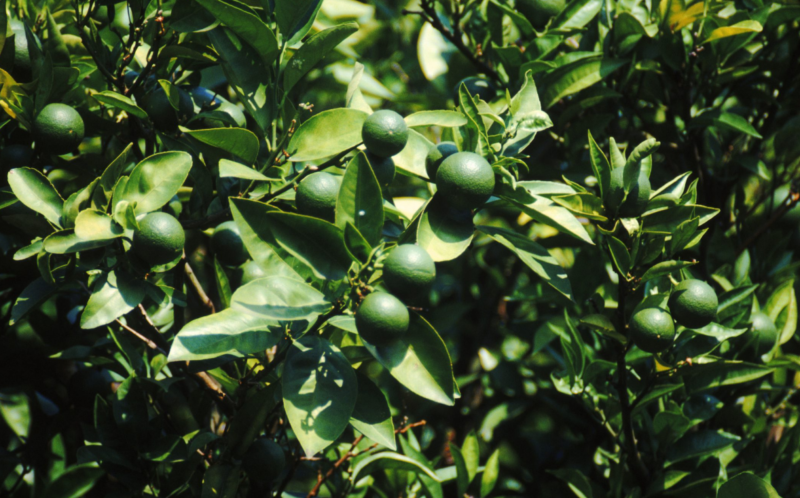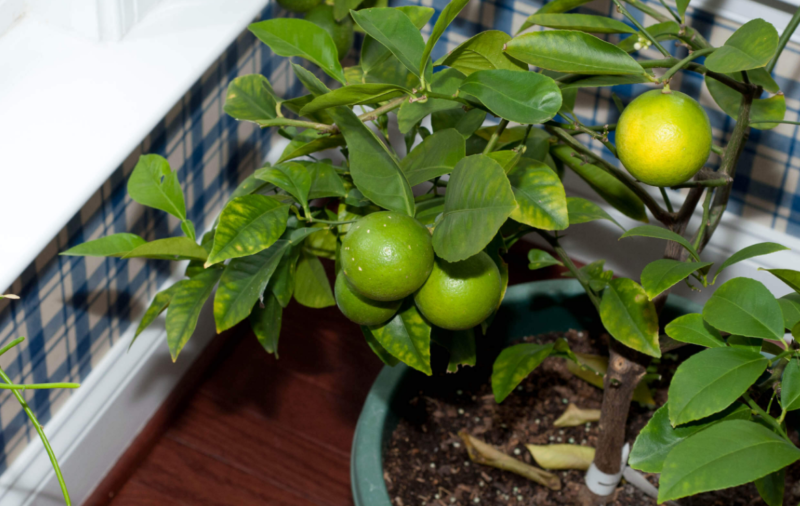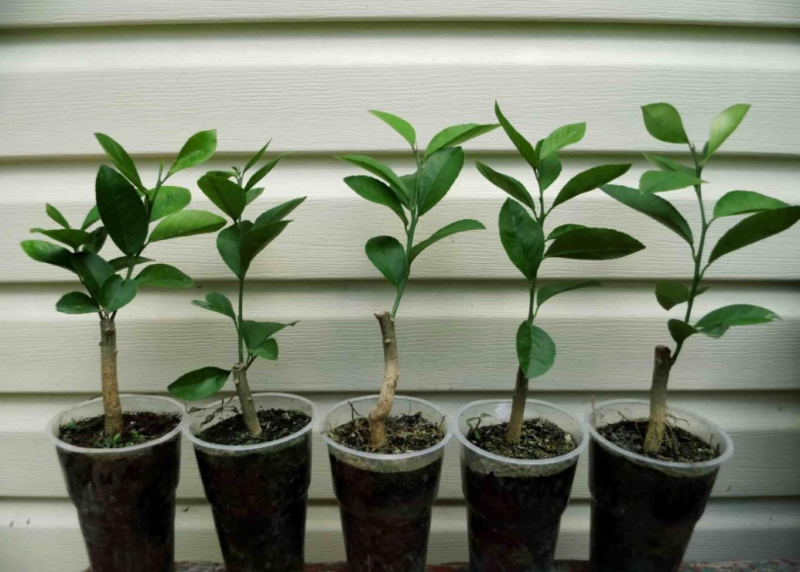Growing lime at home, enjoying the delightful aroma of a flowering tree, picking fruits, and drinking tea with fragrant fruit is the dream of any housewife. For its implementation, you need knowledge of the simple rules of planting, care, a little patience, and you will become the owner of a small miracle on the windowsill.
Material Content:
History of Origin and Botanical Description
Lime is not a variety or hybrid of a lemon, but an independent species belonging to the family of citrus plants, growing in the wild and cultivated in Asia, Australia, Africa, South America in humid subtropical and desert climates. The fruit was brought to the Mediterranean countries by the discoverers of the southern continents, since then citrus has been grown there, enjoys great love and popularity. Lime is also bred in the South Caucasus.
There are many varieties, as well as lime hybrids in a tree and shrub form. The height of the trees is from 1.4 to 5 meters, and the bush is up to 2 meters. The leaves are dense, leathery, with a waxy coating to retain moisture. The trunk and branches are covered with thorns (today plants without thorns are bred). Flowers are collected in inflorescences with a fragrant aroma. The main flowering occurs in the month of May; harvesting is carried out from September to October.
Fruits are small round or ovoid from 50 to 100 grams, the skin is thin, the flesh is juicy. The color of the zest and pulp is green, including the time of full ripening, the fruits of an acidic taste with a citrus aroma and specific notes of freshness.Varieties of plants without thorns on the branches, yellow and orange flowers, sweet and sour and sweet tastes were bred. The fruits are stored in a cool and humid place for about 2 months.
Calorie content and chemical composition
Due to the sour taste and the minimum sugar content in the fruit, its calorie content is 16 kilocalories per 100 grams. The content of proteins, fats and carbohydrates on average is 0.9: 0.1: 3, respectively.
The fruit contains vitamins A, C, E, K, PP, group B, trace elements (calcium, potassium, magnesium, sodium, phosphorus, iron, manganese, copper, selenium, zinc), a set of amino acids and unsaturated fatty acids.
Varieties and hybrids for growing at home
Among the many varieties of lime, several of the most popular, adapted for breeding indoors, stand out.
The Kafir-lime variety, also Kafrsky or Kaffir, has the following characteristics:
- dried leaves replaces the use of bay leaves, giving the dishes a citrus aroma and freshness;
- low juice content in the pulp of fruits, a high concentration of zest essential oils are used to produce essential oils on an industrial scale;
- The plant is suitable for indoor cultivation.
The Mexican variety or real lime (sour lime) is a common species cultivated on many continents:
- universal use for the supply of fresh fruit, the production of juice and essential oil;
- use for breeding hybrids when crossed with lemon, grapefruit, pomelo;
- suitable for home cultivation;
- the absence or small number of seeds in the fruit segments;
- thin fruit peel contributes to the loss of juiciness of growing fruits, requires constant spraying, humidification, storage in containers with water, plastic bags.
The Finger-lime variety has special properties:
- the Australian variety, which is very popular because of the type of juice bags in the form of round pans, containing fruit juice in various colors - white, yellow, green, pink, red;
- thin skin, practically without loose white pulp under the zest;
- maximum fruit juice content.
In addition to those described above, the following varieties and hybrids of lime are popular with gardeners for indoor breeding:
- "Palestinian" or "Sweet" variety - with uniform year-round flowering and gradual ripening of the crop, sweet-tart taste, peel and flesh of light yellow color;
- "Tahiti" variegated - a repairing variety that has an exotic motley color of leaves and original striped fruits, a minimum number of seeds;
- "Rangpur" - a hybrid with mandarin, which has orange zest and pink-red flesh, sweet-sour taste, spherical crown, leaves and young shoots with a purple tint, pink flowers;
- "Limequat" (limonella) - a hybrid of lime with kumquat, the fruits are elongated, from light green to orange, sweet taste;
- "Neapolitanum" - one of the oldest varieties, seedless, sour, very fragrant, appreciated by culinary experts, growing slowly;
- "Santa Barbara" - a hybrid with mandarin, sour, blooms and bears fruit throughout the year, the flesh and zest are orange.
How to grow lime with your own hands
Growing lime at home can be done in three ways. - from seedlings, young shoots (cuttings), fruit seeds.
Growing from seedlings:
- when buying a seedling with an open root system, it is soaked in a tool to stimulate the growth of the root system, according to the instructions;
- the pot is selected in accordance with the size of the root system, an excess volume of the container will serve the intensive root growth and slow the growth of the plant;
- land is bought specifically for citrus fruits; soil is independently made up of turf land, washed from clay river sand, peat, rotted leaves, with the exception of land taken from oak (acidic environment);
- the expanded clay filter layer, cracked clay shards, washed river pebbles are laid at the bottom;
- a seedling bought in a pot with a minimum amount of soil is left without a transplant for acclimatization in the apartment, choosing a suitable place;
- after 2-3 months, when signs of the beginning of growth will be observed, carefully, without damaging the earthen lump, the plant is transplanted into a new container.
Grow seedlings from a young shoot begin with the onset of spring, sunny warm days (late April to early May):
- for the cuttings choose a green shoot (1 year);
- the lower edge is cut under the kidney, the upper middle in the middle between the kidneys, 5-6 kidneys are left on the handle;
- the lower cut of the shank is dipped in a dry mixture of "Kornevin" with crushed coal (equally);
- the stem is placed in water at room temperature, separated from chlorine and poured into a glass container, placed in a sunny place;
- after a week, swelling of the kidneys and the appearance of white roots are observed;
- if the roots develop slowly, they are dipped in the solution "Kornevin" (1 milliliter per 1 liter of water), incubated for a day;
- when the water blooms, it is changed, the roots are washed with warm water;
- with the development of a strong root system, the shoot is planted in a small pot, after the development of 3 young shoots with leaves, the plant is transplanted with a lump of earth, without filling the neck of growth.
The tree can be successfully grown from seed, the only drawback is the long start of fruiting:
- the bone, liked by the shape and taste of the fruit, is washed from the pulp, kept according to the instructions in a solution of a growth stimulator;
- planted in containers with a volume of 250-300 milliliters, to a depth of 1 centimeter, covered with glass or plastic wrap, placed in a warm, well-lit place;
- the ground is regularly ventilated so as not to mold;
- shoots appear a month after planting;
- the seedling is transplanted in a year.
You need to know how to properly care for the trees.
The rules are the same for seedlings grown in any way:
- lime is kept on the sunny side under diffused sunbeams;
- watering is carried out regularly, avoiding drying out and waterlogging of the earth;
- the plant needs daily spraying and a regular warm shower;
- when the ambient air warms up to 20 ° C, the tree is taken out into the air;
- transplantation is carried out in case of an increase in the volume of roots and their exit from the drainage holes, choosing a larger container;
- top dressing is carried out with the universal tool "Potassium humate" with periodicity and concentration in accordance with the instructions;
- stimulation of flowering and development of the fruit is carried out with the preparation “Bud-stimulator”;
- the formation of the crown and the size of the plant is carried out from the first year of growing in the winter, by pinching and trimming the vertical shoots;
- proper care of lime allows you to grow a tree and get the first fruits from seedlings or shoots in the second year, from the seeds - in the third year of life.
Useful properties for the body
Lime is deservedly popular among gardeners, since, in addition to aesthetic decoration of the interior, it has many useful properties due to the active substances in the fruits and leaves of the plant:
- the bactericidal properties of the essential oils of leaves and zest contribute to the aromatization and disinfection of the living environment from pathogenic effects of microorganisms and viruses;
- in cosmetology, lime juice and essential oil are added to masks for the purpose of whitening freckles and age spots of tightening and nutrition of vitamins of the skin of the face and neck in adulthood, as an antiseptic in the treatment of acne, in the care of the cuticle of the nail plate and for strengthening nails;
- a rich set of vitamins and minerals allows you to use lime as a means of strengthening immunity, a tonic and antibacterial agent in the treatment of colds and infectious diseases, taking it as part of a warming drink;
- a high content of ascorbic acid promotes blood thinning, the work of the liver, stomach, heart, blood vessels, has a beneficial effect in rheumatic diseases of the joints and varicose veins.
Cooking Application
Lime is widely used in cooking:
- as a preservative in canned vegetables;
- as a flavoring and preservative when cooking jams, preserves, marmalade, marmalade;
- in hot drinks when brewing tea, coffee;
- when preparing soft drinks, ice cream, sorbet, fresh;
- finger lime fingertips are used to decorate dishes and make sandwiches;
- essential oil is prepared from the zest to enhance the taste;
- dried leaves replace bay leaf;
- for the preparation of sauces for fish, meat, vegetable dishes.
Harm and contraindications
The high content of ascorbic acid causes an acidic taste of lime and contraindications for diseases of the stomach, liver, pancreas during their exacerbation. With these diseases, lime is consumed in limited quantities.
An allergic reaction to citrus and essential oils, individual fruit intolerance are contraindications to the cultivation of this plant in the house.
Knowledge and observance of the rules of growing lime at home, perseverance and dedication to achieve the goal will be the reward in the form of juicy fragrant fruits, which you only have to reach out and pick from a tree branch growing on the windowsill. The aroma and beauty of flowering lime will bring aesthetic pleasure to households and guests. Exotic fruit will expand the possibilities of the hostess in the preparation of desserts, snacks and hot dishes, which will be loved by loved ones.

















